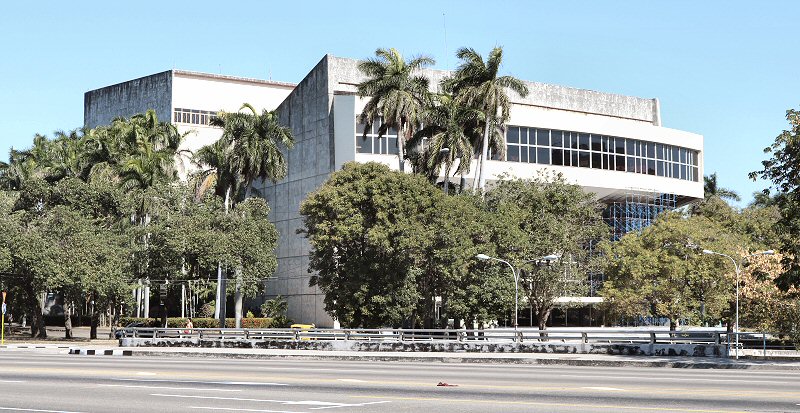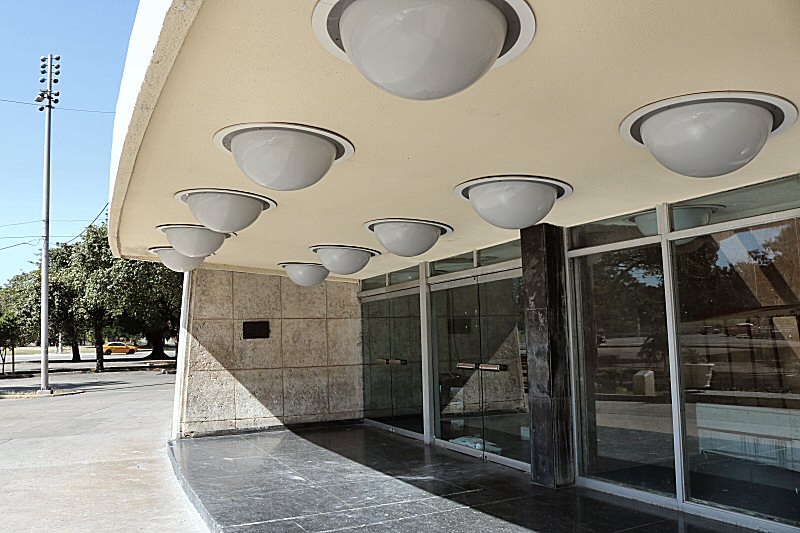

 The
Teatro Nacional de Cuba is a cultural institution that promotes
authentic values of national and international culture in all
artistic manifestations.
The
Teatro Nacional de Cuba is a cultural institution that promotes
authentic values of national and international culture in all
artistic manifestations.
In the past, the plot on that the building of the Teatro
Nacional de Cuba stands today, was the property of more than one
people. About 2/3 of the area belonged to the Company Investor
Conill SA, whereas Mrs. Cecilia Sarrá was the owner of one third
of it. When the construction of the José Martí Memorial began to
go well, it was decided to position some important
administrative and cultural buildings around the square called
the Plaza Cívica (current Plaza de la Revolución), like the
National Library and the National Theatre of Cuba. In 1951, on
the initiative of the engineer Manuel Febles Valdés, the
Minister of Public conceived to carry out the construction
project of the National Theatre of Cuba, and the President
Carlos Prío Socarrás entrusted the Junta Directiva (Board of
Trustees) to run a contest to select the preliminary design of
the building that would serve as the National Theatre of Cuba.
The first prize was awarded by the Cuban architect Julio Conesa,
although there is no document that confirms that the project
executed has been truly the one that was awarded. The
acquisition of the land took time due to bureaucratic
procedures. It was 1952, when the first stone was laid with a
ceremony in that the President Fulgencio Batista took part and
made a speech; however, nothing changed from the aspect of the
construction due to political atmosphere and the unwieldiness of
the new government. At the end of 1952, a contract was signed
with the renowned North American company Purdy and Henderson
that built also some important buildings in Havana like Lonja
del Comercio. The company undertook the project to complete it
in 18 months at a cost of 2.275.000 USD. The architect Nicolás
Arroyo Márquez that would build the Barlovento (current Marina
Hemingway) in the incoming years, was entrusted as technical and
facultative director of the work. Finally, the construction
process of the National Theatre of Cuba started. The concern of
the press was great, as the construction work proceeded very
slowly.
Three months before the anticipated opening date, the name that
would be given to the theatre became a matter of debate. The
name of Teatro de la Avellanada, in homage to the prestigious
Cuban literary writer Gertrudis Gómez de Avellaneda, was
supported by the majority. However, when the budget was
exhausted, the planned opening date was postponed.
After the Revolution, the construction process accelerated, but
the opening date and the final budget was still unknown, as the
plans were in the hands of the previous team and the new
appointed architects and personnel could not proceed due to lack
of data. In 1959, the Teatro Nacional Gertrudis Gómez de
Avellaneda was approved by the law and Isabel Monal, considered
one of the great intellectuals of the revolutionary period, was
appointed the first director. Five departments were created in
the theatre: folklore, music, dramatic arts, dance and cultural
exchange. It was concluded to name the small hall Sala
Covarrubias and the big hall Sala Avellaneda. Even though, the
building was not completed yet, and its halls didn’t meet the
minimum requirements, the Sala Covarrubias was used for a
concert given by the Russian violinist Leonid Kogan and the
composer and the conductor Aram Jachaturian in 1960. This led to
the pre-opening of the Sala Covarrubias with modern dance shows,
directed by Ramiro Guerra and Argeliers León, and the concerts
and recitals of the Symphony Orchestra. The same year, for the
first time a drama, The Respectful Harlot by Jean-Paul Sartre,
adapted by Francisco Martin, was staged in Sala Covarrubias,
gaining great success by about 16.000 spectators in 15 settings.
It was a great surprise for Jean-Paul Sartre that also attended
one of the performances during his visit to Cuba. From then on,
the premieres of several dramas followed one another in Sala
Covarrubias. The children were also not forgotten: El lindo
Ruiseñor, José Martí’s version of a story by Hans Christian
Andersen was premiered by Herberto Dumé in 1960.
Beginning with 1961, dramas, dance shows (modern dance and folklore) and children’s theater were discontinued due to precarious conditions of the Sala Covarrubias, so that this hall started to serve as a rehearsal room for some works and later, as storage room of furniture and decorative material. On the other hand, in the period of 1959 and 1964 the construction works of the theater continued slowly, as the restoration of the great provincial theaters in the country were limiting the budget that was mainly reserved for the construction of the National Theatre. On the other hand, the installation of the technical equipment, acquired from the German Democratic Republic, raised some difficulties. In 1964, all the constructive activity in the building was stopped and the theatre was left semi-built until the second half of the 1970s, when the construction process resumed. Finally, in 1979, 20 years after the Revolution, the National Theatre of Cuba opened its doors with a gala to the delegates, attending the 6th Summit Conference of Non-aligned Countries that was held in Havana.
